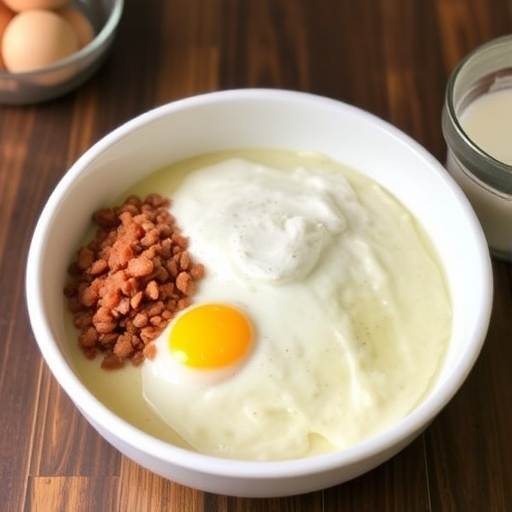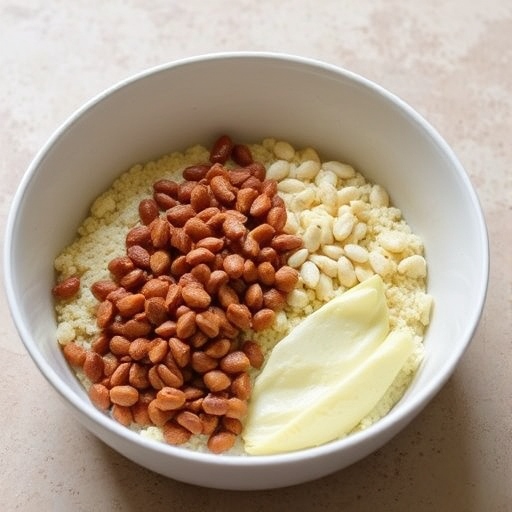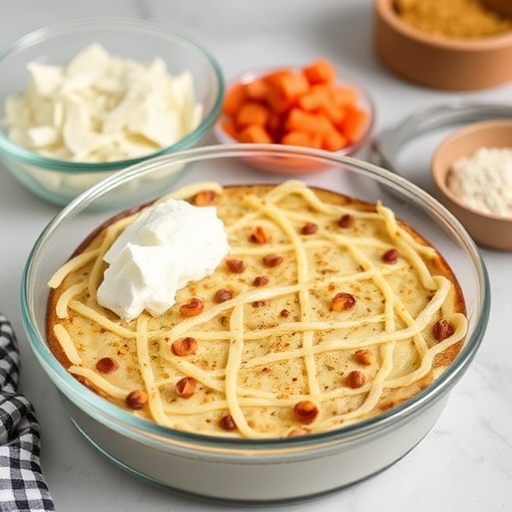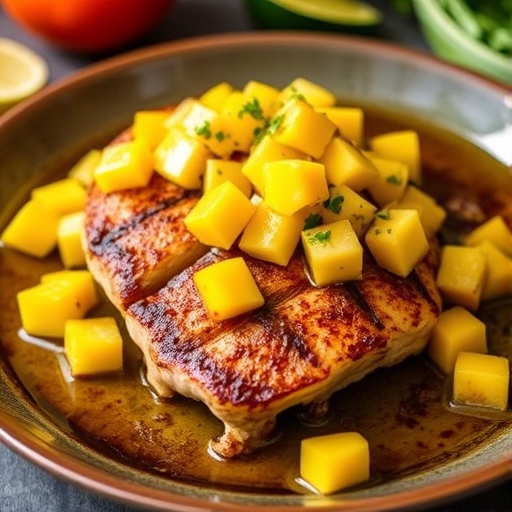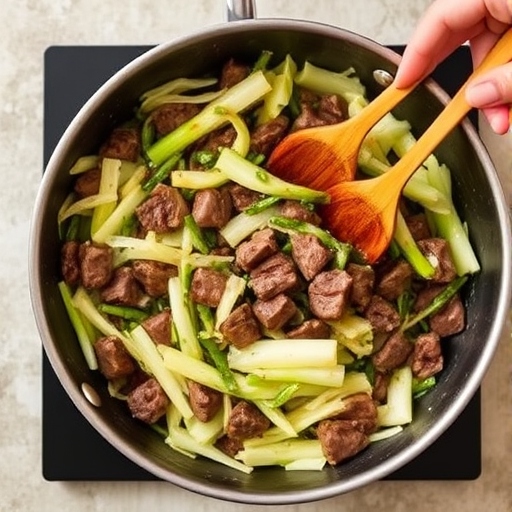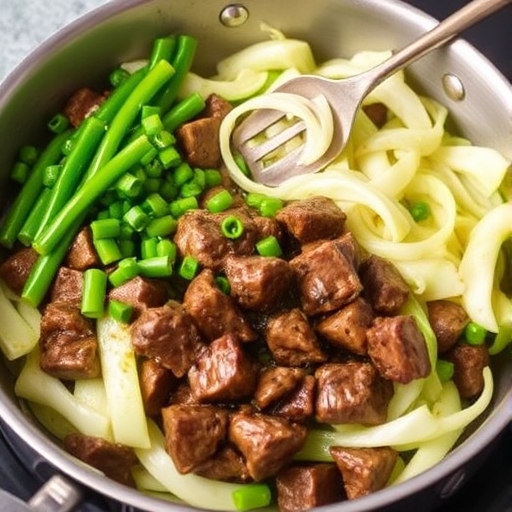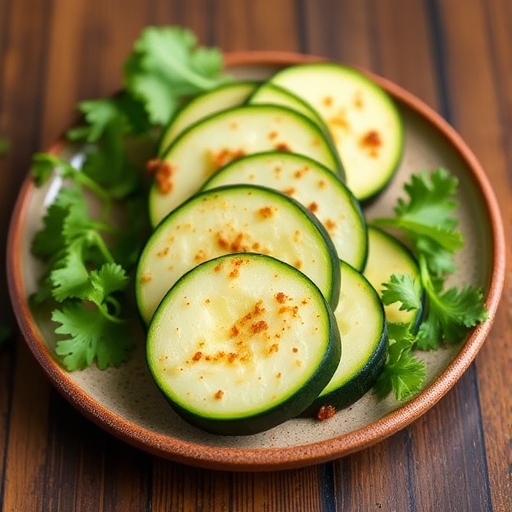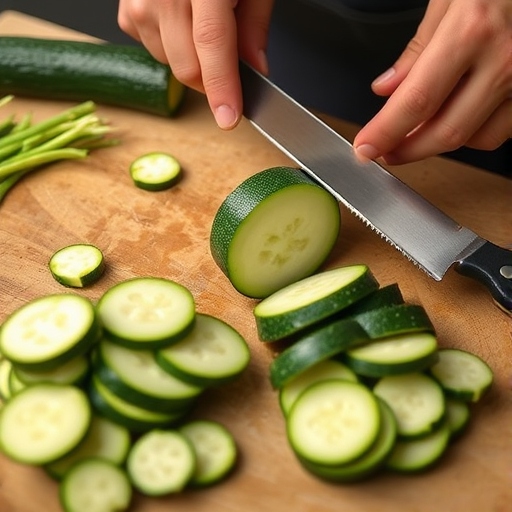Introduction
Chicken potpie is a classic comfort food that never fails to bring warmth and satisfaction to any meal. With its flaky, golden crust and creamy filling of tender chicken, vegetables, and savory herbs, it’s a dish that’s both hearty and heartwarming. Whether you’re making it for a family dinner or a special occasion, this chicken potpie is sure to be a crowd-pleaser.
Table of Contents
The Story Behind Chicken Potpie
The origins of chicken potpie can be traced back to the ancient Greeks and Romans, who first experimented with pastry-covered dishes. However, the modern version, which became popular in the United States in the 19th century, is often associated with the classic comfort food traditions of New England. In this version, chicken and vegetables are simmered together in a creamy sauce, encased in a buttery, flaky pastry crust. Over the years, chicken potpie has evolved into a beloved comfort dish, enjoyed by families for generations.
The Benefits of Making Your Own Chicken Potpie
- Control Over Ingredients: You can choose high-quality, fresh ingredients, ensuring a healthier, more flavorful meal.
- Customization: Make it exactly to your taste—add extra vegetables, spices, or a different type of crust.
- Satisfying Meal: The combination of creamy filling and flaky crust provides a perfectly balanced meal in one dish.
- Freezing for Later: Chicken potpie freezes well, making it an excellent option for meal prepping or future dinners.
Essential Ingredients for the Perfect Chicken Potpie
For the Filling:
- 2 tablespoons unsalted butter
- 1 medium onion, diced
- 2 garlic cloves, minced
- 3 medium carrots, peeled and diced
- 2 celery stalks, diced
- 1 cup frozen peas
- 4 cups cooked chicken, shredded or diced (rotisserie chicken works well)
- 2 ½ cups chicken broth
- 1 cup heavy cream
- 1 teaspoon dried thyme
- 1 teaspoon dried rosemary
- Salt and pepper to taste
- 2 tablespoons all-purpose flour (for thickening)
For the Crust:
- 2 ½ cups all-purpose flour
- 1 teaspoon salt
- 1 cup unsalted butter, cold and cut into cubes
- 6 tablespoons ice water (more if needed)
- 1 egg (for egg wash, optional)

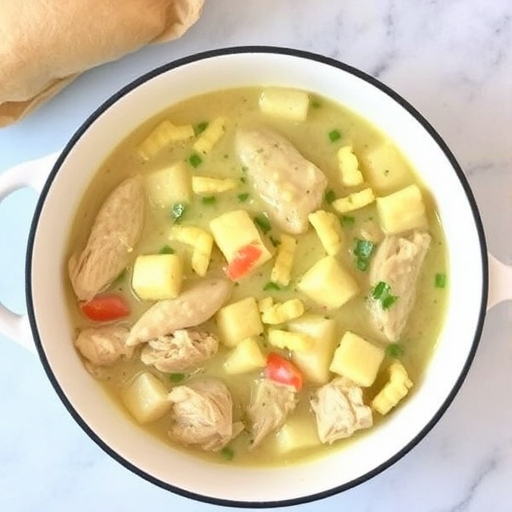
Cultural History of Ingredients
- Chicken: A common protein in Western cuisine, it serves as the base for the rich, comforting filling in potpie.
- Carrots and Celery: These vegetables are the backbone of many classic soups and stews, contributing both flavor and texture.
- Pastry Crust: A buttery, flaky crust adds an indulgent touch to the dish, with its origins in European cooking, where pastries were used to encase fillings for ease and portability.
Equipment You’ll Need
- Oven: For baking the potpie to golden perfection.
- Skillet or Dutch Oven: For preparing the filling.
- Rolling Pin: For rolling out the dough.
- Pie Dish: To assemble and bake the potpie.
- Pastry Brush: For brushing the crust with the egg wash.
- Knife and Cutting Board: For chopping vegetables and chicken.
Step-by-Step Instructions for Chicken Potpie
Step 1: Make the Pie Crust
- In a large bowl, combine the flour and salt. Add the cold butter and cut it into the flour using a pastry cutter or your hands until the mixture resembles coarse crumbs.
- Gradually add the ice water, one tablespoon at a time, mixing with a fork until the dough starts to come together.
- Turn the dough out onto a floured surface and knead gently until it forms a smooth ball. Wrap it in plastic wrap and refrigerate for at least 30 minutes.
Step 2: Prepare the Filling
- In a large skillet or Dutch oven, melt the butter over medium heat. Add the diced onion, garlic, carrots, and celery. Sauté for about 5 minutes until the vegetables begin to soften.
- Stir in the flour and cook for 1-2 minutes to form a roux.
- Gradually pour in the chicken broth while stirring, then add the cream, thyme, rosemary, salt, and pepper. Simmer for 5 minutes, allowing the sauce to thicken.
- Add the cooked chicken and frozen peas, stirring to combine. Adjust seasoning as needed.
- Remove from heat and set aside to cool slightly while you prepare the crust.
Step 3: Assemble the Potpie
- Preheat your oven to 400°F (200°C).
- Roll out the chilled dough on a floured surface to fit your pie dish. You will need a top and bottom crust.
- Place one piece of dough in the bottom of your pie dish, pressing it gently into place.
- Pour the chicken filling into the pie dish, spreading it evenly.
- Roll out the second piece of dough and place it over the filling. Trim any excess dough, and crimp the edges to seal the pie.
- Cut a few small slits in the top of the crust to allow steam to escape. Optionally, brush the top with a beaten egg for a golden finish.
Step 4: Bake the Potpie
- Bake the potpie in the preheated oven for 30-35 minutes, or until the crust is golden brown and the filling is bubbling.
- Allow the potpie to rest for 5-10 minutes before slicing and serving.
Suggestions for Serving and Storing
- Serving: Serve with a side salad or some roasted vegetables for a balanced meal.
- Storing: Leftover chicken potpie can be stored in an airtight container in the refrigerator for up to 3 days. Reheat in the oven for the best texture. You can also freeze the entire potpie before baking; just thaw and bake when needed.
Chef Simon’s Tips for Chicken Potpie
- Flavor Boost: Add a splash of white wine to the filling for added depth of flavor.
- Crust Alternatives: If you’re short on time, you can use store-bought puff pastry or pie dough.
- Make It Veggie-Heavy: For a lighter version, add more vegetables, such as mushrooms, parsnips, or zucchini.
Emotional and Psychological Impact of Food
Chicken potpie is more than just a meal; it’s a reminder of home and family. The warmth and richness of the dish provide a sense of comfort, while the act of making it can be therapeutic. It brings people together, evoking feelings of nostalgia and contentment with every bite.
Mindful Cooking Techniques
- Savor the Process: Take your time rolling out the dough and assembling the potpie—it’s a chance to slow down and enjoy the creative process of making something homemade.
- Smell the Aroma: As the filling simmers and the crust bakes, take a moment to appreciate the delightful aromas that fill your kitchen.
Tips for Keeping the Recipe Fresh Longer
- Store Separately: Keep the pie crust and filling separate if you plan to store leftovers. The crust stays crisp when kept apart from the filling.
- Cover Well: If freezing, wrap the assembled potpie in plastic wrap and aluminum foil to prevent freezer burn.
Advanced Culinary Terms and Techniques
- Roux: A mixture of fat (butter) and flour used to thicken sauces and soups.
- Blind Baking: A technique where the crust is pre-baked before adding the filling to ensure it stays crisp.
- Egg Wash: A mixture of beaten egg and water or milk brushed on the crust to create a golden finish.
Healthy Ingredient Alternatives
- Crust: Use a whole-wheat or almond flour-based crust for a healthier, gluten-free option.
- Cream: Swap out the heavy cream for a lighter option, like half-and-half or coconut cream, to reduce fat.
- Vegetarian Version: Replace the chicken with tofu or chickpeas and add extra vegetables like spinach or kale.
More Serving Ideas
- Mini Potpies: Make individual-sized potpies for a fun, portion-controlled dinner.
- Potpie Soup: Transform the filling into a soup by adding more broth and serving it with crusty bread on the side.
Common Issues and Solutions
- Soggy Bottom Crust: To prevent a soggy bottom, make sure the filling is not too runny, and pre-bake the crust for a few minutes before adding the filling.
- Overcooked Chicken: Be careful not to overcook the chicken when adding it to the filling. If you’re using leftover chicken, add it in at the end to avoid drying it out.
Variations to Try
- Chicken and Mushroom Potpie: Add sautéed mushrooms for an earthy twist.
- Spicy Chicken Potpie: Add jalapeños or a dash of hot sauce to spice things up.
- Curry Chicken Potpie: Add curry powder or a little coconut milk to give the filling a unique flavor.
Nutritional Information and Health Benefits
Per Serving (1 slice):
- Calories: 450
- Protein: 25g
- Fat: 30g
- Carbohydrates: 35g
- Fiber: 4g
- Sugars: 5g
- Sodium: 500mg
Health Benefits:
Chicken potpie is a balanced meal that provides a good amount of protein from the chicken, vitamins from the vegetables, and healthy fats from the butter and cream. The dish can be made even healthier by using whole-wheat flour for the crust or substituting the cream with lighter alternatives. Additionally, vegetables like carrots, celery, and peas contribute essential nutrients such as fiber, vitamins A and C, and antioxidants, making this a well-rounded and comforting dish.
The Art of Pairing Chicken Potpie
Chicken potpie pairs wonderfully with a crisp, refreshing salad or roasted vegetables to balance the richness of the filling. Consider a light vinaigrette salad with mixed greens, tomatoes, and a citrus dressing to complement the savory flavors of the pie. For a more hearty side, roasted root vegetables like sweet potatoes or parsnips work wonderfully.
Weather and Recipe Outcome
Chicken potpie is perfect for cooler weather, especially during the fall and winter months when you want a comforting, filling meal. The warm, hearty filling and golden crust are ideal for enjoying after a day in the cold. On a rainy day, it becomes an even more indulgent choice to enjoy with a hot drink, wrapped in a cozy blanket.
Other Chicken Recipes to Explore
- Chicken Alfredo: A creamy, cheesy pasta dish that’s both comforting and indulgent.
- Chicken Parmesan: Breaded chicken topped with marinara sauce and melted mozzarella, perfect for a hearty dinner.
- Grilled Chicken Salad: A lighter option with marinated grilled chicken served over fresh greens.
Focus on Tools and Equipment
To create the perfect chicken potpie, having the right tools can make the process easier:
- Pastry Cutter: For cutting the butter into the flour to achieve the perfect flaky crust.
- Dutch Oven: Ideal for making the filling, as it provides an even heat for sautéing and simmering.
- Pie Dish: A classic glass or ceramic pie dish is perfect for even baking and serving.
Frequently Asked Questions (with answers)
Q1: Can I make chicken potpie ahead of time?
Yes! You can assemble the potpie in advance and store it in the refrigerator for up to 24 hours before baking. If freezing, wrap the pie well in plastic wrap and aluminum foil before placing it in the freezer. Bake from frozen, adding extra time to the baking process.
Q2: Can I use store-bought pie crust?
Absolutely! If you’re short on time, store-bought pie crusts are a great option. Just ensure they’re pre-baked if you’re using a bottom crust, or use them as-is for a top crust.
Q3: How do I reheat leftover chicken potpie?
To reheat leftover chicken potpie, cover it with foil and bake in a 350°F oven for about 20 minutes, or until heated through. If reheating individual slices, microwave for 2-3 minutes, but the crust may not stay as crispy.
Q4: Can I use a different protein besides chicken?
Yes! You can use turkey, beef, or even a vegetarian filling like mushrooms and tofu for a twist on the classic.
Q5: Can I make a gluten-free chicken potpie?
Yes, you can make a gluten-free chicken potpie by using gluten-free flour for the crust and ensuring your filling ingredients are gluten-free.
Conclusion
Chicken potpie is the ultimate comfort food, offering the perfect balance of flavors, textures, and warmth. It’s a dish that brings people together and can be customized to suit your tastes or dietary needs. Whether you make it from scratch or opt for store-bought shortcuts, this hearty meal is guaranteed to satisfy. So, roll up your sleeves, gather your ingredients, and create a comforting chicken potpie that everyone will love. Bon appétit!
Thank you for visiting SqueezyRecipes! We’re dedicated to making cooking enjoyable and accessible for everyone, regardless of your skill level. Chef Simon is always ready to share the best recipes that bring a creative touch to your daily meals. With each visit, you’ll discover new recipes and innovative ideas that cater to every occasion. Don’t miss out on exploring SqueezyRecipes for the latest delicious dishes, and feel free to leave your feedback and share your experiences with the recipes you’ve tried. Cooking together makes everything better!



